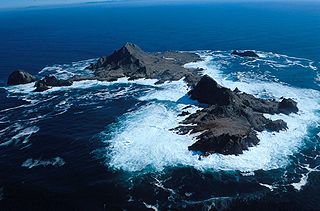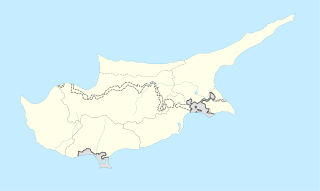
The Komodo dragon, also known as the Komodo monitor, is a species of lizard found in the Indonesian islands of Komodo, Rinca, Flores, and Gili Motang. A member of the monitor lizard family Varanidae, it is the largest extant species of lizard, growing to a maximum length of 3 metres (10 ft) in rare cases, and weighing up to approximately 70 kilograms (150 lb).

The Gulf of Saint Lawrence is the outlet of the North American Great Lakes via the Saint Lawrence River into the Atlantic Ocean. The gulf is a semi-enclosed sea, covering an area of about 226,000 square kilometres (87,000 sq mi) and containing about 34,500 cubic kilometres (8,300 cu mi) of water, which results in an average depth of 152 metres (499 ft).

The Arctic Archipelago, also known as the Canadian Arctic Archipelago, is an archipelago lying to the north of the Canadian continental mainland, excluding Greenland.

The razorbill or lesser auk is a colonial seabird in the monotypic genus Alca of the family Alcidae, the auks. It is the closest living relative of the extinct great auk. Wild populations live in the subarctic waters of the Atlantic Ocean.

The Farallon Islands, or Farallones, are a group of islands and sea stacks in the Gulf of the Farallones, off the coast of San Francisco, California, United States. The islands are also sometimes referred to by mariners as the Devil's Teeth Islands, in reference to the many treacherous underwater shoals in their vicinity. The islands lie 30 miles (48 km) outside the Golden Gate and 20 miles (32 km) south of Point Reyes, and are visible from the mainland on clear days. The islands are part of the City and County of San Francisco. The only inhabited portion of the islands is on Southeast Farallon Island (SEFI), where researchers from Point Blue Conservation Science and the U.S. Fish and Wildlife Service stay. The islands are closed to the public.

Cape Farewell is a headland on the southern shore of Egger Island, Nunap Isua Archipelago, Greenland. As the southernmost point of the country, it is one of the important landmarks of Greenland.

The swallow-tailed gull is an equatorial seabird in the gull family, Laridae. It is the only species in the genus Creagrus, which derives from the Latin Creagra and the Greek kreourgos which means butcher, also from kreas, meat; according to Jobling it would mean "hook for meat" referring to the hooked bill of this species. It was first described by French naturalist and surgeon Adolphe-Simon Neboux in 1846. Its scientific name is originally derived from the Greek word for gull, "Glaros" and via Latin Larus, "gull" and furca "two-tined fork". It spends most of its life flying and hunting over the open ocean. The main breeding location is in the Galápagos Islands, particularly the rocky shores and cliffs of Hood, Tower and Wolf Islands, with lower numbers on most of the other islands. It is more common on the eastern islands where the water is warmer.

The Slovene Littoral is one of the five traditional regions of Slovenia. Its name recalls the former Austrian Littoral, the Habsburg possessions on the upper Adriatic coast, which the Slovene Littoral was part of.

Miliou is a village on the island of Cyprus.
Turnabout Glacier is located on Ellesmere Island, Nunavut, Canada. It is drained by the Turnabout River.

La Tortuga Island is an uninhabited island of Venezuela, the largest in the Federal Dependencies of Venezuela. It is part of a group of islands that include the Tortuguillos and Cayo Herradura. Isla La Tortuga has an area of 156 km2 (60 sq mi).

Egg Island is a small island in the Fox Islands subgroup of the Aleutian Islands in the U.S. state of Alaska. It lies off the eastern end of Unalaska Island and just off the northeastern tip of Sedanka Island. It is the easternmost island in the Aleutians West Census Area of Alaska. The island has a land area of 311.12 acres (1.259 km2) and is uninhabited.

The coconut crab is a species of terrestrial hermit crab, also known as the robber crab or palm thief. It is the largest terrestrial arthropod in the world, with a weight up to 4.1 kg (9.0 lb). It can grow to up to 1 m in length from each tip to tip of the leg. It is found on islands across the Indian Ocean, and parts of the Pacific Ocean as far east as the Gambier Islands and Pitcairn Islands, similar to the distribution of the coconut palm; it has been extirpated from most areas with a significant human population, including mainland Australia and Madagascar. Coconut crabs also live off the coast of Africa near Zanzibar.

Port Foster is one of the safest harbours in Antarctica, located in Deception Island in the South Shetland Islands.

Delta Junction Airport is a public use airport located in and owned by Delta Junction, a city in the Southeast Fairbanks Census Area of the U.S. state of Alaska.
Egg Rock in Nahant Bay near Nahant, Massachusetts is a small (3-acre) island at 42.4333°N 70.8978°W. It was formerly the site of a lighthouse known as Egg Rock Light but now is owned by the state of Massachusetts as a bird sanctuary. Egg Rock can be seen clearly from the coasts of Nahant, Swampscott, and Lynn. Egg Rock is the setting for Sylvia Plath's poem "Suicide off Egg Rock", and also appears in her novel, The Bell Jar.

The eastern great egret, a white heron in the genus Ardea, is usually considered a subspecies of the great egret. In New Zealand it is known as the white heron or by its Māori name kōtuku. The subspecies was first described by British ornithologist John Edward Gray in 1831.

Balchen Glacier is a crevassed glacier in Antarctica, flowing west to Block Bay between the Phillips Mountains and the Fosdick Mountains in Marie Byrd Land. It was discovered on December 5, 1929, by the Byrd Antarctic Expedition and named by Richard E. Byrd for Bernt Balchen, chief pilot of the expedition.

Eggøya is a peninsula of Jan Mayen island of the Arctic Ocean. It is located on the southern side, in the central part of the island, east of Sørlaguna, and defines the northeastern extension of the bay Rekvedbukta. To the west of the peninsula is the bay Eggøybukta, and to the east is the bay Jamesonbukta. The highest peak at the peninsula has a height of 217 m.a.s.l. Eggøya consists of the northern part of an old volcanic crater, and small hydrothermal vents are still present. The outer part of the peninsula forms the semicircular bay of Kraterbukta, facing south-southeast with steep slopes. To the south of the peninsula is a small islet, Eggøykalven.















